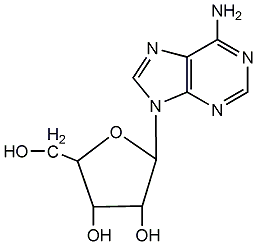
Structural formula
| Business number | 019N |
|---|---|
| Molecular formula | C10H13N5O4 |
| Molecular weight | 267.24 |
| label |
trypsin, Purine nucleosides, Urine nucleosides, glycosides, Adenine riboside, 6-Amino-9-β-D-ribofuranosyl-9H-pruine, Adenine-9-β-D-ribofuranoside, Adenine riboside, Adenoscan, 9-β-D-Ribouranosyl-9H-purin-6-amine, antiarrhythmic drugs |
Numbering system
CAS number:58-61-7
MDL number:MFCD00005752
EINECS number:200-389-9
RTECS number:AU7175000
BRN number:93029
PubChem number:24277685
Physical property data
1. Properties: White crystalline powder. Odorless. Sensitive to light and air.
2. Density (g/mL, 25/4℃): Undetermined
3. Relative vapor density (g/mL, air=1): Undetermined
4. Melting point (ºC): 234-235
5. Boiling point (ºC, normal pressure): Undetermined
6. Boiling point (ºC, 5.2kPa): Undetermined
7. Refractive index: Undetermined
8. Flash point (ºC): Undetermined
9. Specific rotation (º): [ -61.7°(C=0.706, water); -58.2°(C=0.658, water).
10. Autoignition point or ignition temperature (ºC): Undetermined
11. Vapor pressure (kPa, 25ºC): Undetermined
12. Saturation Vapor pressure (kPa, 60ºC): Undetermined
13. Heat of combustion (KJ/mol): Undetermined
14. Critical temperature (ºC): Undetermined
15. Critical pressure (KPa): Undetermined
16. Log value of oil-water (octanol/water) partition coefficient: Undetermined
17. Explosion upper limit (% ,V/V): Undetermined
18. Lower explosion limit (%,V/V): Undetermined
19. Solubility: Easily soluble in water, more soluble when hot , the solubility increases significantly in the presence of impurities, and it is almost insoluble in ethanol and ether.
Toxicological data
1. Acute toxicity: Intravenous TDLo in women: 240ug/kg; Intravenous TDLo in men: 143ug/kg/I; Intravenous TDLo in men: 50ug/kg/1M-I; Intravenous TDLo in women: 360ug/kg/1H-I; Intravenous TDLo in men: : 257ug/kg; male intravenous TDLo: 171ug/kg; male intravenous TDLo: 257ug/kg/1D-I; mouse menstrual��LD50: >20mg/kg; Mouse abdominal LD50: 500mg/kg
2. Mutagenicity: Phage inhibition capacityTEST system: Bacteria – Escherichia coli: 1mg/L; Mutation test system – not other specifiedTEST systems: Human cells – not otherwise specified: 100umol/L; genetic analysis: mouse peritoneal cavity: 178mg/kg; DNA damageTEST system: mammal – species not lymphocytes: 60mmol/L;
Ecological data
None
Molecular structure data
1. Molar refractive index: 59.95
2. Molar volume (cm3/mol): 128.1
3. Isotonic specific volume (90.2K ): 412.8
4. Surface tension (dyne/cm): 107.6
5. Polarizability (10-24cm3): 23.76
Compute chemical data
1. Reference value for hydrophobic parameter calculation (XlogP): None
2. Number of hydrogen bond donors: 4
3. Number of hydrogen bond acceptors: 8
4. Number of rotatable chemical bonds: 2
5. Number of tautomers: 3
6. Topological molecule polar surface area 140
7. Number of heavy atoms: 19
8. Surface charge: 0
9. Complexity: 335
10. Number of isotope atoms: 0
11. Determine the number of atomic stereocenters: 4
12. Uncertain number of atomic stereocenters: 0
13. Determine the number of chemical bond stereocenters: 0
14. Number of uncertain chemical bond stereocenters: 0
15. Number of covalent bond units: 1
Properties and stability
1. Avoid inhaling the dust of this product and avoid contact with eyes and skin.
Storage method
Seal with argon and store in a dry and dark place at 4°C.
Synthesis method
None
Purpose
1. Antiarrhythmic drugs can convert paroxysmal supraventricular tachycardia into sinus rhythm. For supraventricular arrhythmias related to the atrioventricular region.
2.Treatment of angina pectoris, myocardial infarction, coronary insufficiency, Arteriosclerosis, essential hypertension, cerebrovascular disorders, stroke sequelae, progressive muscle atrophy, etc.
3. Biochemical research.

 微信扫一扫打赏
微信扫一扫打赏

